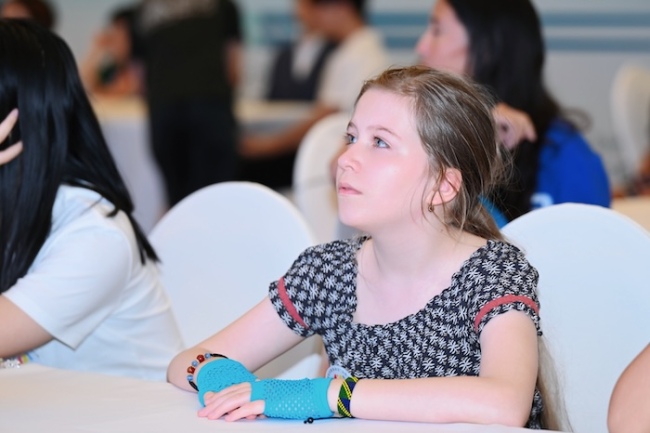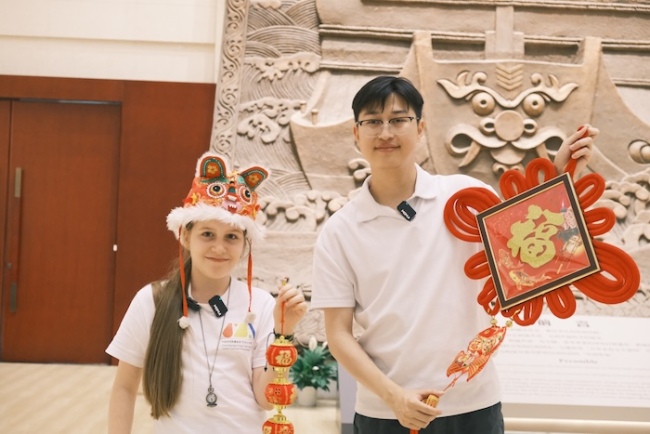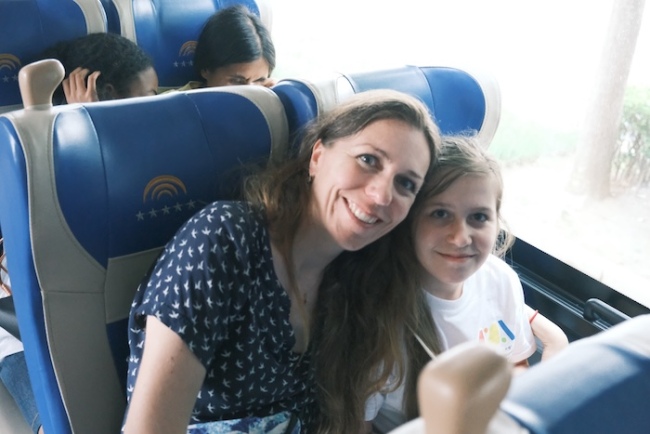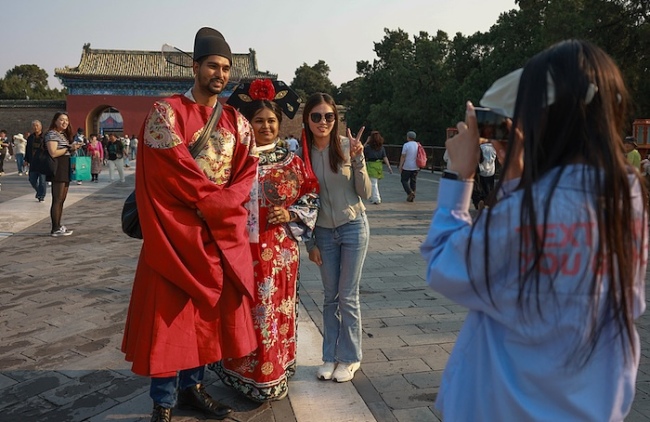日期:2025-09-11 10:39:05

编者按:在全球化深入发展的今天,旅行不仅仅是跨越地理边界的行走,更提供了与不同文明对话的机会。随着中国免签政策的深入实施,“China Travel”的热度持续攀升。越来越多的外国游客带着好奇与期待走进中国配资论坛开户,用脚步丈量这片古老又充满活力的土地。从舌尖上的美味到层出不穷的视觉盛宴,从千年古迹到市井烟火,每一次真实的体验都在不断刷新他们对中国的认知。在由宋庆龄基金会主办的“文化小大使”国际交流活动中,Hélène Sophie Reiner向我们描述了她眼里的中国。

图为Hélène在中国印象·沙龙活动现场
“大家好,我是Hélène,我今年11岁。我是一半英国人,一半瑞士人。”Hélène是一个安静害羞的女孩,现在居住在德国柏林。这是Hélène第二次来到北京,在此次中国之行中,她参观了故宫、长城等历史遗迹。
“我觉得北京是一个漂亮的城市,”Hélène认真地回答道,“我很喜欢这里的文化,尤其是中国美食。”

图为Hélène接受采访现场
提到中国美食,Hélène渐渐放松了下来,主动与我们分享她品尝到的食物:“我很喜欢吃火锅和北京烤鸭,但最喜欢的还是火锅。”比起刺激味蕾的麻辣火锅,Hélène更偏爱酸甜的番茄火锅,她也希望能够把火锅分享给自己在德国的朋友。
不过,中国美食带来的也不全是惊喜。当被问及不能接受的中国食物时,Hélène犹豫了一下,说:“鸡爪,它看起来有点吓人。”
“那你是否愿意把鸡爪介绍给你在德国的朋友呢?”
“No!”Hélène几乎脱口而出。从她困惑又有些抗拒的表情中不难看出,鸡爪确实给这位“文化小大使”带来了不小的饮食冲击。

图为Hélène在中国印象·沙龙活动现场选用美食
在许多国家的饮食传统中,鸡爪这类食材往往被视为边角料,难逃被丢弃的命运。然而在中国厨师的手中,经过卤、炸、炖、泡等传统烹饪工艺的精心料理,鸡爪华丽蜕变为极具地方特色的美味佳肴——广式豉汁蒸凤爪、泡椒凤爪、虎皮凤爪……虽然完整的鸡爪形态可能让一些外国食客望而却步,但这道菜总能成为餐桌上不可忽视的存在。
食物的外观能够给食用者带来最直接的感官体验,气味也是。尽管鲱鱼罐头这一瑞典传统食物在中国已经“名声大噪”,但总有人试图突破自己的味觉舒适区,使其一度成为互联网的“流量密码”。这种勇敢尝试来自对异域文化的好奇,本身也是一次跨越文化隔阂的实践。

图为虎皮凤爪

图为鲱鱼罐头
在跨文化饮食交流的过程中,那些具有鲜明感官辨识度的食物,往往凭借其带给人的强烈的第一印象,成为文化体验中新的标志性符号。当人们在“难以下咽”与“跃跃欲试”间摇摆时,其文化认知也在经历着微妙的重构。这种看似矛盾的心理状态,超越了简单的猎奇,成为文明对话极具生命力的开端。正如Hélène对鸡爪抗拒又好奇的反应所展现的那样,当一种全新的食物挑战着我们的味觉习惯时,它也在拓展着我们对食物的认知与定义。这种感官体验的突破,能自然地激起人们探索异域文化的热情,成为跨文化理解的原始动力。
在与中国相遇的时间里,Hélène通过亲身体验与观察,看到了一个真实的北京。这里有比柏林更多的高楼大厦和更多的人,也有着丰富多彩的文化和厚重的历史底蕴。对Hélène而言,此刻,中国不再只是明信片上的画面,而是可以触摸、可以感知的真实存在。

图为Hélène与家人的合照
随着中国对外开放的不断深入和免签政策的持续扩容,越来越多的外国游客与Hélène一样来到中国,透过自己的眼睛了解中国。截至目前,适用中国单方面免签政策国家达47个,适用240小时过境免签政策国家达55个。今年上半年,全国各口岸入境外国人均呈现了大幅度增长。免签政策消去的不仅是一道手续,更是外国游客进入中国的心理屏障。

图为外国游客在中国体验传统服饰
文明需要对话。纵观人类文明史,无论是陆上丝绸之路的驼铃声声,还是大航海时代的帆影重重,各文明都曾以不同的方式主动向外探索。张骞为寻月氏出使西域,促进了中原与西域各民族之间的接触与融合;马可·波罗带着对东方文明的好奇来到中国,留下《马可·波罗游记》,在西方掀起一股“中国热”。尽管在过去,距离与差异让对话有了隔阂。但此刻,中国以开放友好的姿态迎接四海宾朋,外国游客也主动走进中国,拥抱中国文化。两颗真诚的心跨越万水千山终于相遇。

图为Hélène在采访现场与采编人员的合照
当下持续升温的“中国热”,不再是单向的文化输出,而是建立在双向理解基础上的深度对话。当外国游客背起行囊走进中国的大街小巷,曾经只出现在书本影像中的“东方世界”在亲身体验中变得真实可感。想象的迷雾散去,中国文化的真实轮廓逐渐清晰。这种转变让文化认知突破了刻板符号的限制,向外传递出更加真实的中国形象。或许,免签政策的意义也在于此:让不同文化背景的人们在真实的互动中重新认识彼此,让人类文明在主动相遇中获得理解与共鸣。
责任编辑:何博媛
A Surging "China Craze": Where Civilizations Meet in a Mutual Journey
Editor's Note: In today's deeply globalized world, travel is not just about crossing geographical boundaries; it also offers opportunities for dialogue with different civilizations. With the deeper implementation of China's visa-free policies, the popularity of "China Travel" continues to rise. More and more foreign tourists are coming to China with curiosity and expectation, measuring this ancient yet vibrant land with their footsteps. From culinary delights to an endless feast for the eyes, from millennia-old historical sites to the everyday hustle and bustle, each real experience continuously reshapes their perception of China. At the Junior Cultural Ambassadors international exchange event hosted by the China Soong Ching Ling Foundation, Hélène Sophie Reiner described China through her eyes.
"Hello everyone, I'm Hélène, and I'm 11 years old this year. I'm half British and half Swiss." Hélène is a quiet and shy girl who currently lives in Berlin, Germany. This was Hélène's second visit to Beijing, and during this trip to China, she visited historical sites such as the Forbidden City and the Great Wall.
"I think Beijing is a beautiful city," Hélène answered earnestly, "I really like the culture here, especially Chinese food."
When mentioning Chinese food, Hélène gradually relaxed and began to actively share the foods she had tasted with us: "I really like hotpot and Peking duck, but my favorite is hotpot." Compared to the stimulating spicy hotpot, Hélène preferred the sweet and sour tomato hotpot, and she hoped to share hotpot with her friends in Germany.
However, Chinese food did not bring only surprises. When asked about Chinese foods she couldn't accept, Hélène hesitated for a moment and said, "Chicken feet, they look a bit scary."
"Then would you be willing to introduce chicken feet to your friends in Germany?"
"No!" Hélène almost blurted out. From her confused and somewhat resistant expression, it was clear that chicken feet indeed brought a considerable dietary shock to this junior cultural ambassador.
In the culinary traditions of many countries, ingredients like chicken feet are often considered scraps and are destined to be discarded. However, in the hands of Chinese chefs, after meticulous preparation through traditional cooking processes such as braising, frying, stewing, and pickling, chicken feet are transformed into highly distinctive local delicacies—Cantonese steamed phoenix claws with fermented black beans(广式豉汁蒸凤爪), pickled pepper phoenix claws(泡脚凤爪), tiger skin phoenix claws(虎皮凤爪)... Although the complete form of chicken feet might deter some foreign diners, its presence at the table cannot be ignored.
The appearance of food can bring the most direct sensory experience to eaters, and so can smell. Although surströmming, a traditional Swedish food, has gained "notoriety" in China, some people always try to break through their taste comfort zone, making it a "traffic password" on the internet. This brave attempt, stemming from curiosity about exotic cultures, is itself a practice of overcoming cultural barriers.
In the process of cross-cultural dietary exchange, foods with distinct sensory recognition often become new iconic symbols in cultural experiences due to the strong first impression they leave. When people oscillate between "unable to stomach" and "eager to try" these foods, their cultural cognition also undergoes a subtle reconstruction. This seemingly contradictory psychological state transcends simple curiosity, becoming a vibrant beginning for civilizational dialogue. As Hélène's resistant yet curious reaction to chicken feet demonstrates, when a new food challenges our taste habits, it also expands our understanding and definition of food. This breakthrough in sensory experience can naturally ignite people's enthusiasm for exploring exotic cultures, becoming the primitive driving force for cross-cultural understanding.
During her time encountering China, Hélène saw a real Beijing through her personal experience and observation. Here, there are more skyscrapers and more people than in Berlin, as well as a rich and colorful culture and profound historical heritage. For Hélène, at this moment, China is no longer just a picture on a postcard, but a real existence that can be touched and perceived.
As China's opening-up deepens and its visa-free policies continue to expand, more and more foreign tourists, like Hélène, are coming to China to understand it through their own eyes. As of now, 47 countries are eligible for China's unilateral visa-free policy, and an additional 55 countries are eligible for the 240-hour transit visa-free policy. In the first half of this year, the number of foreign visitors entering China through various ports saw a significant increase. The visa-free policy not only removes a procedure but also a psychological barrier for foreign tourists entering China.
Civilizations need dialogue. Throughout the history of human civilization, whether it was the sound of camel bells on the Silk Road or the countless sails of the Age of Exploration, various civilizations have actively explored outwards in different ways. Zhang Qian's mission to the Western Regions in search of the Yuezhi promoted contact and integration among the Central Plains and the ethnic groups of the Western Regions; Marco Polo came to China with curiosity about Eastern civilization, leaving behind "The Travels of Marco Polo," which sparked a "China craze" in the West. Although in the past, distance and differences created barriers to dialogue, now, China welcomes guests from all over the world with an open and friendly attitude, and foreign tourists are actively coming to China to embrace Chinese culture. Two sincere hearts, crossing mountains and rivers, finally meet.
The current surging "China Craze" is no longer a one-way cultural output but a deep dialogue based on mutual understanding. When foreign tourists pack their bags and walk into the streets and alleys of China配资论坛开户, the "Oriental world," which once only appeared in books and images, becomes tangible and real through personal experience. The mists of imagination dissipate, and the true contours of Chinese culture gradually become clear. This transformation allows cultural cognition to break through the limitations of stereotypical symbols, conveying a more authentic image of China to the outside world. Perhaps the significance of the visa-free policy lies precisely in this: allowing people from different cultural backgrounds to re-understand each other through real interactions, and enabling human civilizations to achieve understanding and resonance through active encounters.
鑫配网官网提示:文章来自网络,不代表本站观点。



